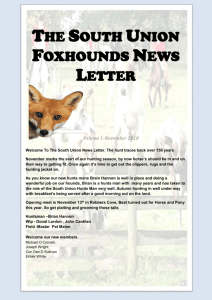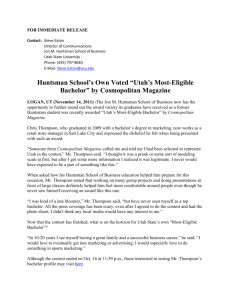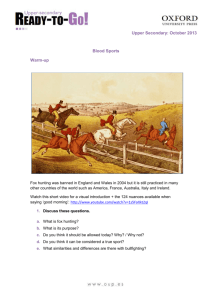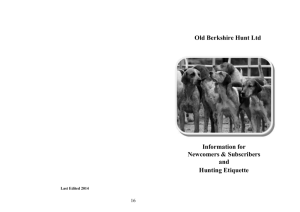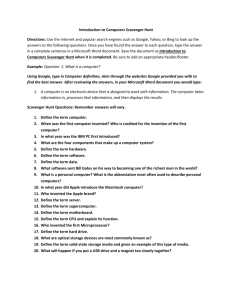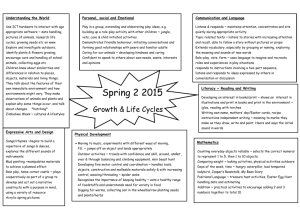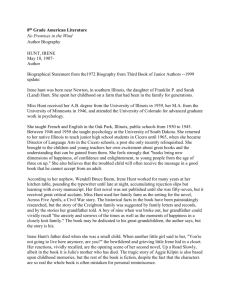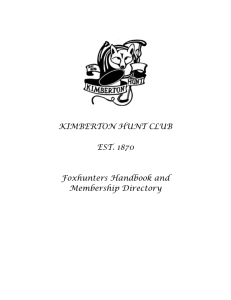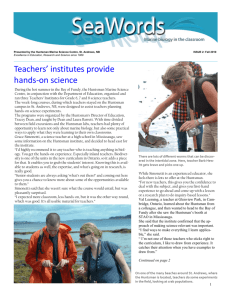Fox Hunting 101 - Raccoon Valley Pony Club
advertisement
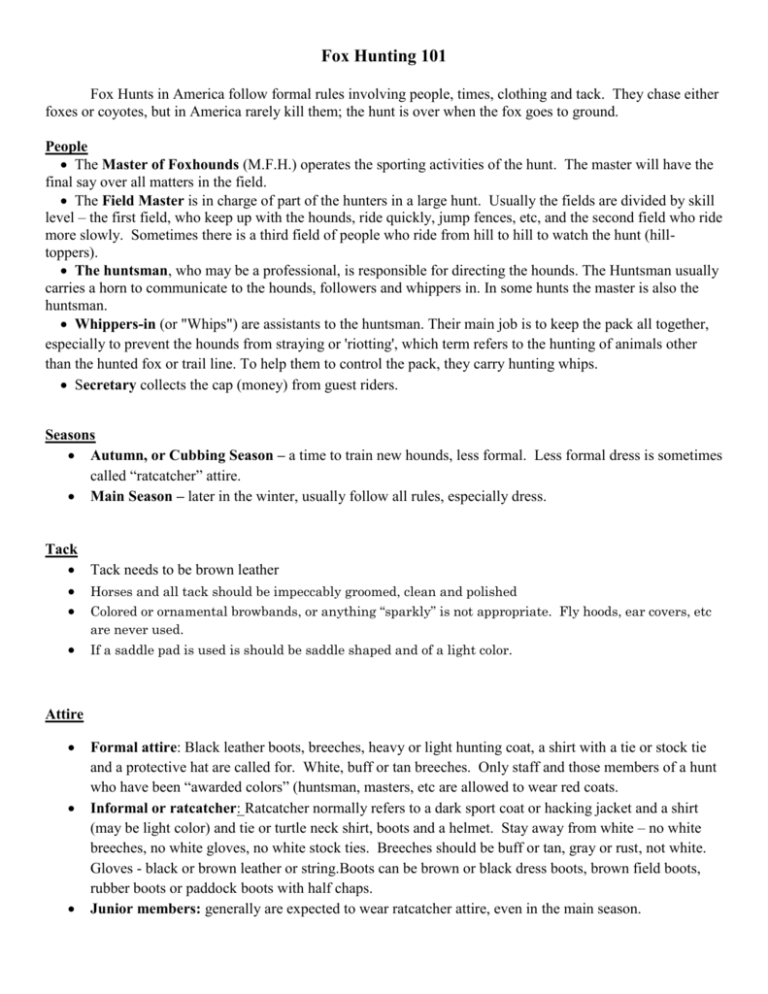
Fox Hunting 101 Fox Hunts in America follow formal rules involving people, times, clothing and tack. They chase either foxes or coyotes, but in America rarely kill them; the hunt is over when the fox goes to ground. People The Master of Foxhounds (M.F.H.) operates the sporting activities of the hunt. The master will have the final say over all matters in the field. The Field Master is in charge of part of the hunters in a large hunt. Usually the fields are divided by skill level – the first field, who keep up with the hounds, ride quickly, jump fences, etc, and the second field who ride more slowly. Sometimes there is a third field of people who ride from hill to hill to watch the hunt (hilltoppers). The huntsman, who may be a professional, is responsible for directing the hounds. The Huntsman usually carries a horn to communicate to the hounds, followers and whippers in. In some hunts the master is also the huntsman. Whippers-in (or "Whips") are assistants to the huntsman. Their main job is to keep the pack all together, especially to prevent the hounds from straying or 'riotting', which term refers to the hunting of animals other than the hunted fox or trail line. To help them to control the pack, they carry hunting whips. Secretary collects the cap (money) from guest riders. Seasons Autumn, or Cubbing Season – a time to train new hounds, less formal. Less formal dress is sometimes called “ratcatcher” attire. Main Season – later in the winter, usually follow all rules, especially dress. Tack Tack needs to be brown leather Horses and all tack should be impeccably groomed, clean and polished Colored or ornamental browbands, or anything “sparkly” is not appropriate. Fly hoods, ear covers, etc are never used. If a saddle pad is used is should be saddle shaped and of a light color. Attire Formal attire: Black leather boots, breeches, heavy or light hunting coat, a shirt with a tie or stock tie and a protective hat are called for. White, buff or tan breeches. Only staff and those members of a hunt who have been “awarded colors” (huntsman, masters, etc are allowed to wear red coats. Informal or ratcatcher: Ratcatcher normally refers to a dark sport coat or hacking jacket and a shirt (may be light color) and tie or turtle neck shirt, boots and a helmet. Stay away from white – no white breeches, no white gloves, no white stock ties. Breeches should be buff or tan, gray or rust, not white. Gloves - black or brown leather or string.Boots can be brown or black dress boots, brown field boots, rubber boots or paddock boots with half chaps. Junior members: generally are expected to wear ratcatcher attire, even in the main season. Horn Calls Horn is arried by the Huntsman. It both commands the hounds, and lets the Field know what is going on. One short blast – the hunt has begun Several short blasts – the fox has been sighted Long call – fox has gone to ground Series of fast rattles – fox has broken from covert and the chase is on Very long call – hunt is over Rules and Guidelines If you are a guest and capping, seek out the hunt secretary to ensure that you are recorded as being on the hunt and pay your capping fee before the hunt moves out. It is your responsibility to find the secretary, not the secretary’s to find you. Arrive early, and make sure to greet and thank the Master. Never leave the field without notifying the Field Master or another person if it’s not feasible to talk to the Field Master. Never talk to or rate (try to correct) a hound. Do not speak to one another when close to hounds. Never speak their names where they can hear you. Anything that brings a hounds head up distracts from their hunting. Never get between a hound and the huntsman. Always keep your horse a safe distance from other horses. You should ride either with the member of the Hunt who invited you, or at the back of the field, if you are new. If you find a gate open, leave it open; if you have to open a gate, close it behind you. Never ride across hunt country on non-hunting days unless you have permission from the landowner. Always volunteer to open gates when appropriate. If someone opens a gate for you, make sure you or someone stays behind with that person. Horses get anxious when left, so it’s a good idea to stay and help the person getting the gate. Always ride on the edge of fields whenever possible. Never cross seeded areas unless the Field Master leads you. Never jump anything the Field Master does not unless told to take your own line. If the Field Masters goes through a gate with a jump next to it, everyone goes through the gate. Whenever riding near livestock slow down and walk if possible At the end of the day it is appropriate to stay in the field until the Master has released the hounds and huntsman for the day. It’s then appropriate to thank the huntsman and staff and to leave the field. It is not appropriate to talk to the Huntsman before this, as he will be busy with the hounds.


